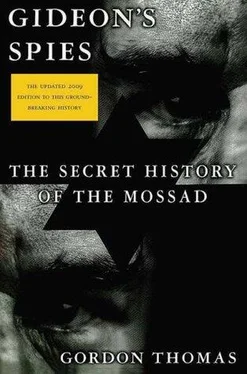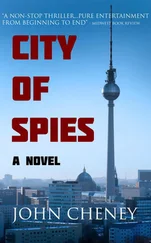Gordon Thomas - Gideon's Spies
Здесь есть возможность читать онлайн «Gordon Thomas - Gideon's Spies» весь текст электронной книги совершенно бесплатно (целиком полную версию без сокращений). В некоторых случаях можно слушать аудио, скачать через торрент в формате fb2 и присутствует краткое содержание. Город: New York, Год выпуска: 2009, ISBN: 2009, Издательство: Thomas Dunne Books, Жанр: История, на английском языке. Описание произведения, (предисловие) а так же отзывы посетителей доступны на портале библиотеки ЛибКат.
- Название:Gideon's Spies
- Автор:
- Издательство:Thomas Dunne Books
- Жанр:
- Год:2009
- Город:New York
- ISBN:978-0-312-53901-6
- Рейтинг книги:4 / 5. Голосов: 1
-
Избранное:Добавить в избранное
- Отзывы:
-
Ваша оценка:
- 80
- 1
- 2
- 3
- 4
- 5
Gideon's Spies: краткое содержание, описание и аннотация
Предлагаем к чтению аннотацию, описание, краткое содержание или предисловие (зависит от того, что написал сам автор книги «Gideon's Spies»). Если вы не нашли необходимую информацию о книге — напишите в комментариях, мы постараемся отыскать её.
Gideon’s Spies
Gideon's Spies — читать онлайн бесплатно полную книгу (весь текст) целиком
Ниже представлен текст книги, разбитый по страницам. Система сохранения места последней прочитанной страницы, позволяет с удобством читать онлайн бесплатно книгу «Gideon's Spies», без необходимости каждый раз заново искать на чём Вы остановились. Поставьте закладку, и сможете в любой момент перейти на страницу, на которой закончили чтение.
Интервал:
Закладка:
On his trips, Eitan traveled as “adviser on security and counterterrorism” to Israel’s prime minister, Ariel Sharon, a longtime friend. In early 2004, Eitan had visited the Los Alamos area, home of America’s cutting-edge nuclear technology. In 1985, he had arranged to sell to Los Alamos’s Sandia Laboratories a copy of the Israeli version of Promis software. The program’s “trapdoor” enabled Israel to learn something of Sandia’s work in providing U.S. nuclear submarines with the latest computer technology. Pollard provided further details, which are contained in Caspar Weinberger’s still secret affidavit.
By April 2004 the sayanim had been fully mobilized. Eitan made no secret of their role. Quoting Meir Amit, he confirmed (to the author): “Sayanim fulfill many functions. A car sayan, running a rental agency, lets his handler know if any suspicious person has rented a car. A Realtor sayan provides similar information on anyone seeking accommodation. Sayanim also collect technical data and all kinds of overt intelligence. A rumor at a cocktail party, an item on the radio, a paragraph in a newspaper, a story overheard at a dinner party.”
It was a sayan in Phoenix, Arizona, who discovered in the spring of 2004 that one of the most notorious figures in the history of the Catholic church, Archbishop Paul Marcinkus, had kept his undertaking never to divulge what he knew about Mossad’s role in the disappearance of $200 million. It had been sent to the Polish Solidarity movement by the Vatican Bank when Marcinkus had been its president.
By the early 1980s, Marcinkus was implicated in massive financial scandals and a stunning list of other crimes, including “being involved in arms smuggling, trafficking in stolen gold, counterfeit currencies, and radioactive materials,” according to an indictment lodged by the Rome public prosecutor in 1989. The charges were still on the open file in April 2004. Marcinkus was never interviewed or arrested. Pope John Paul II allowed him to remain in the Vatican so that he could be protected under the city’s sovereign immunity, which had been granted to the Holy See in 1929 by Benito Mussolini.
Then one night—the date remains one of the Vatican’s many secrets—Marcinkus was quietly driven out of the Vatican in a car bearing diplomatic plates. Next day he arrived in Chicago. From there he was flown to Sun City, a satellite town in Phoenix. Close by lived another colorful character, Victor Ostrovsky. The former Mossad officer was a whistleblower. Like Ari Ben-Menashe, Ostrovsky had revealed many of Mossad’s secrets in interviews. Both men in 2004 still lived comfortable lives. But Marcinkus, at eighty years of age, was living out his closing years in a modest white-painted cinder-block house close to a country club fairway in Sun City. Unlike the two Mossad officers, he had still kept the silence when he was known as God’s banker and a confidant of popes—Paul VI, John Paul I, and his now dying successor, Pope John Paul II. The Polish pope, the supreme pontiff to the Catholic world, was the one man, apart from Marcinkus, who could answer the question: What was Mossad’s role in the mystery of the missing $200 million?
The mystery can properly be said to have begun when another limousine arrived at the Vatican.
Close to midnight the dark blue limousine, with its diplomatic plates, stopped before the wrought-iron gates of the Arch of the Bells, the gateway to the Apostolic Palace in the Vatican. It was the prelude to a sequence of events that to this day cast a dark shadow over the pontificate of John Paul. Now, as he waits to die, the answer to questions that will form the final judgment on his long rule is a deeply troubling one for all those who care about the church and what was done in its name.
Did the pope allow himself to be moved from his own personal moral standards to help Solidarity because of his passionate and abiding commitment to Poland? Was he purely an innocent and unsuspecting victim of what was about to transpire once that limousine entered the Vatican?
In the judgment of David Yallop, the English financial investigator long recognized as the bête noir of the secret financial world of the Vatican, John Paul allowed his papacy “to become a triumph for wheeler-dealers and the international financial thieves. The pope also gave his blessing for large quantities of U.S. dollars to have been sent, secretly and illegally, to Solidarity.”
Christopher Story, the publisher of the International Currency Review, the journal of the banking world, called it “one of the great black hole mysteries of modern-day financing.”
Certainly on that April night in 1983 when the Renaissance-costumed Swiss Guard, caped against the cold, stepped forward to salute the Fiat’s passenger, it signaled the start of a chain of staggering events. They began at a period John Paul had called “a very dark time in the history of the world.” Two years before, the KGB—through its surrogate, the Bulgarian secret service—had tried to assassinate him in St. Peter’s Square. To further distance itself, Moscow had allowed a Muslim fanatic, Mehmet Ali Agca, to carry out the attempt. Until his death in April 2005, the pope felt the pain from the shrapnel still in his body. But his defiance of Communism had led to the creation of the Solidarity movement in Poland. In Washington, President Ronald Reagan had called its birth “an inspiration to the free world. We shall support it.”
How he did so has remained secret. Now the extraordinary and, at times, bizarre story can be told of how the CIA and the Vatican Bank created that $200 million secret fund for Solidarity. In 1983, the CIA maintained a well-developed slush fund to mount “no-questions-asked black operations” all over the world.
Richard Brenneke, a mild-mannered man with the careful speech pattern of an accountant, was the senior CIA operative in charge of the agency’s secret funding for those operations. He worked sixteen-hour days juggling covert funds in and out of Swiss banks, like Credit Suisse in Geneva, and sending them on complex transfers around the banking world. With the full authority of CIA director William Casey, Brenneke had started to use the Vatican Bank for money laundering. Casey had introduced Brenneke to Bishop Paul Marcinkus. Brenneke had since made a number of visits to Marcinkus’s office in a seventeenth-century tower inside the Vatican walls. “On a good day $400 million was laundered,” Brenneke recalled. A substantial portion of the money came from the CIA’s ultrasecret operations.
“Like other intelligence agencies, the CIA had established backdoor links with the mafia. The CIA, like the Vatican, had a very real fear Italy could fall into the hands of the Communists. The CIA saw the mafia as a bulwark against that happening. Consequently, the CIA took the view that the mafia’s activities in Italy were to be tolerated if they helped to ensure that NATO member Italy did not fall into Moscow’s hands at the polling booths,” said David Yallop (to the author).
By 1983, the CIA had extended its secret links to international crime to include arming Iran and the contras in Nicaragua. Brenneke said: “Money from guns sold to the Iranians was used by the agency to buy drugs in South America. Cocaine was shipped back to the States and sold on to the mafia. That money was then used to buy weapons for the contras in Nicaragua. It got so out of hand I told President Reagan’s national security adviser, Don Gregg. I was told to forget it.” By then, Brenneke said, he had laundered $10 billion. A considerable portion of the money came from the Gotti mafia family of New York. The Gotti family, like the Gambino and Columbo crime families, were devout Catholics. FBI intercepts show the bosses gave generously to the church. Another mafia chief, Salvatore “Lucky” Luciano, boasted of visiting the Vatican before his death.
Читать дальшеИнтервал:
Закладка:
Похожие книги на «Gideon's Spies»
Представляем Вашему вниманию похожие книги на «Gideon's Spies» списком для выбора. Мы отобрали схожую по названию и смыслу литературу в надежде предоставить читателям больше вариантов отыскать новые, интересные, ещё непрочитанные произведения.
Обсуждение, отзывы о книге «Gideon's Spies» и просто собственные мнения читателей. Оставьте ваши комментарии, напишите, что Вы думаете о произведении, его смысле или главных героях. Укажите что конкретно понравилось, а что нет, и почему Вы так считаете.












